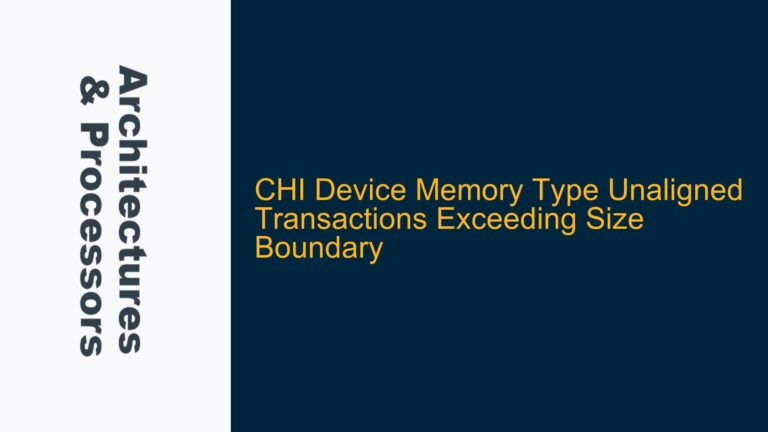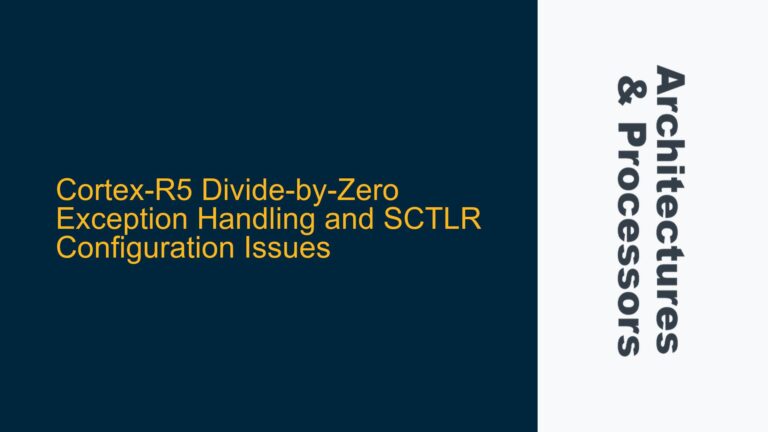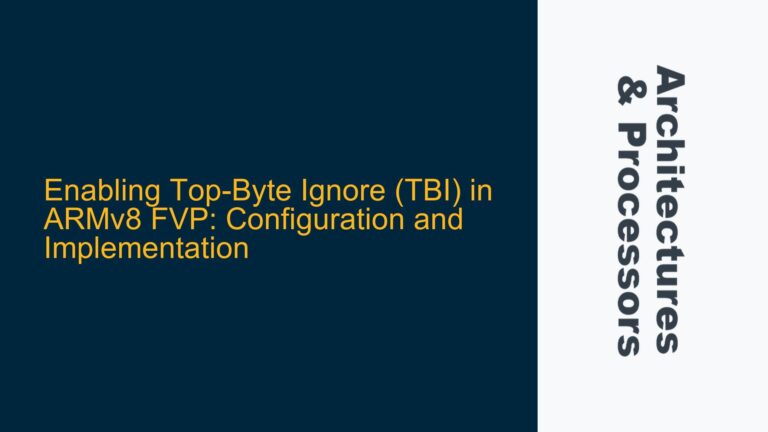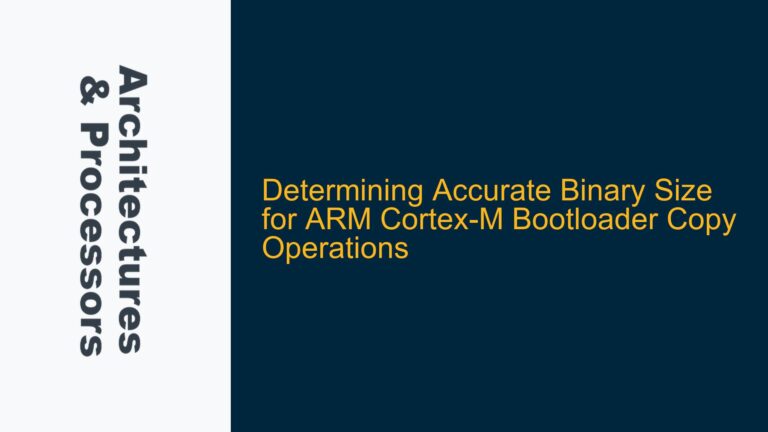Delayed Transaction Propagation and Reduced Visibility in AXI4 Systems
In AXI4-based systems, the visibility of transactions to downstream components is a critical aspect of ensuring system-level coherency and correctness. The AXI4 protocol allows for certain modifications to transactions, such as changes to the memory attributes specified by the AxCACHE signal. However, these modifications must not reduce the visibility of transactions to other components in the system. A key concern arises when an intermediate component delays the propagation of a transaction, particularly when caching mechanisms are involved.
When a transaction is delayed in an intermediate cache, the data associated with that transaction is not immediately visible to downstream components. This delay can lead to reduced visibility, as downstream components will not see the updated data until the cache line is evicted or the write buffer is drained. For example, if a CPU issues a non-bufferable write transaction to ensure that the data is immediately visible to all components, any delay introduced by an intermediate cache would violate this requirement. The downstream components would effectively be operating with stale data until the cache line is evicted, which could lead to incorrect system behavior.
The AxCACHE attribute plays a crucial role in determining how transactions are handled by intermediate components. If a transaction is marked as non-bufferable and non-modifiable, it must propagate all the way to the destination memory without being cached or delayed. Any deviation from this requirement, such as caching the transaction in an intermediate component, would reduce the visibility of the transaction to downstream components. This is particularly problematic in systems where multiple masters are accessing shared memory, as it can lead to coherency issues where different components have different views of the same memory location.
AxCACHE Modification and System-Level Cache Visibility
The AxCACHE attribute in AXI4 transactions defines the cacheability and modifiability of a transaction. When a transaction passes through an intermediate component, the AxCACHE attribute can be modified, but only in a way that does not reduce the visibility of the transaction to downstream components. One specific scenario that raises concerns is when a transaction that originally required a cache lookup is modified to no longer require a cache lookup.
If an intermediate component changes a transaction from requiring a cache lookup to bypassing the cache, this modification can have significant implications for system-level cache visibility. In a system with multiple levels of cache, such as L1, L2, and system-level caches, bypassing a cache lookup can improve visibility for downstream components. For example, if a transaction is modified to bypass the L2 cache, the data will be directly written to or read from the system-level memory, making it immediately visible to all components. This can be beneficial in scenarios where the CPU requires immediate visibility of the data, such as in real-time systems or when dealing with shared memory regions.
However, if the modification reduces the visibility of the transaction, it can lead to coherency issues. For instance, if a transaction that originally required a cache lookup is modified to bypass the cache, but the data is still present in the cache, downstream components may operate on stale data. This is particularly problematic in systems with multiple masters, where one master may be operating on cached data while another master is operating on the most recent data from system memory. Ensuring that AxCACHE modifications do not reduce visibility is therefore critical to maintaining system-level coherency.
FIFO Implementation for Bufferable Transactions in AXI4
In AXI4 systems, bufferable transactions are those that can be temporarily stored in intermediate components before being propagated to downstream components. The use of FIFOs (First-In-First-Out buffers) is a common implementation strategy for handling bufferable transactions. FIFOs provide a simple and efficient way to manage the flow of data between components, ensuring that transactions are processed in the order they are received.
When designing an AXI4-compliant system, the choice of whether to use a FIFO or another buffering mechanism depends on the specific requirements of the system. FIFOs are particularly well-suited for handling bufferable transactions because they provide a predictable and deterministic way to manage data flow. For example, in a system where multiple masters are issuing transactions to a shared slave, a FIFO can be used to ensure that transactions are processed in the order they are received, preventing conflicts and ensuring fair access to the shared resource.
However, the use of FIFOs is not mandatory for handling bufferable transactions. The AXI4 protocol allows for flexibility in the implementation of buffering mechanisms, and designers may choose to use other methods, such as memory with read and write pointers, to achieve the same functionality. The key requirement is that the buffering mechanism must ensure that transactions are processed in a way that does not violate the visibility requirements specified by the AxCACHE attribute.
In summary, the use of FIFOs for handling bufferable transactions in AXI4 systems is a common and effective strategy, but it is not the only option. Designers must carefully consider the specific requirements of their system and choose a buffering mechanism that ensures compliance with the AXI4 protocol while meeting performance and coherency goals.
Troubleshooting AXI4 Modifiable Transaction Issues
When troubleshooting issues related to modifiable transactions in AXI4 systems, it is important to follow a systematic approach that addresses both the architectural and implementation aspects of the design. The following steps provide a comprehensive guide to identifying and resolving common issues related to transaction visibility, AxCACHE modifications, and buffering mechanisms.
Step 1: Verify AxCACHE Attribute Consistency
The first step in troubleshooting modifiable transaction issues is to verify that the AxCACHE attribute is being consistently applied across all transactions to the same address range. This involves checking that intermediate components are not making unauthorized modifications to the AxCACHE attribute that could reduce the visibility of transactions to downstream components. For example, if a transaction is marked as non-bufferable and non-modifiable, it must not be cached or delayed by any intermediate component.
To verify AxCACHE consistency, designers should review the transaction logs and trace the flow of transactions through the system. This can be done using simulation tools that provide detailed visibility into the behavior of each component in the system. Any discrepancies in the AxCACHE attribute should be flagged and investigated to ensure that they do not violate the AXI4 protocol.
Step 2: Analyze Cache Coherency Mechanisms
The next step is to analyze the cache coherency mechanisms in the system to ensure that they are functioning correctly. This involves checking that cache lines are being properly invalidated or flushed when necessary to maintain visibility of transactions. For example, if a transaction is modified to bypass the cache, the cache must be invalidated to ensure that downstream components do not operate on stale data.
Designers should also verify that the cache coherency protocol is correctly implemented and that it is compatible with the AXI4 protocol. This may involve reviewing the cache controller design and ensuring that it correctly handles cache line evictions, writebacks, and invalidations. Any issues with cache coherency should be addressed to ensure that transactions are visible to all components in the system.
Step 3: Evaluate Buffering Mechanisms
The final step is to evaluate the buffering mechanisms used in the system to ensure that they are compliant with the AXI4 protocol and that they do not introduce unnecessary delays or reduce the visibility of transactions. This involves reviewing the design of any FIFOs or other buffering mechanisms and verifying that they are correctly handling bufferable transactions.
Designers should also consider the performance implications of the buffering mechanisms and ensure that they are not introducing bottlenecks in the system. For example, if a FIFO is too small, it may become a bottleneck and delay the propagation of transactions. Conversely, if a FIFO is too large, it may introduce unnecessary latency. The goal is to strike a balance between performance and compliance with the AXI4 protocol.
In conclusion, troubleshooting modifiable transaction issues in AXI4 systems requires a thorough understanding of the protocol and a systematic approach to identifying and resolving issues. By following the steps outlined above, designers can ensure that their systems are compliant with the AXI4 protocol and that transactions are visible to all components in the system.






